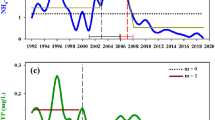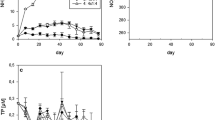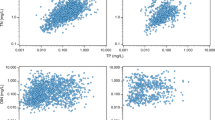Abstract
Lake Kinneret (LK) is a monomictic lake that has undergone significant biological and chemical changes over the last three decades of the twentieth century. The transition between the 1970s and the 1980s attracted a lot of scientific attention as it was marked by significant changes in the ecology of the lake. In the early 1980s, phytoplankton biomass increased, apparently in response to an increase in the external soluble reactive phosphorus (SRP) load. This period was marked by a rise in hypolimnetic levels of ammonium (NH4) and SRP as well as surface water dissolved oxygen (DO) and pH. Cconcomitantly, in surface waters in winter levels of NH4 increased and NO3 decreased. In this study interrelationships amongst these observations were examined with a mass balance modelling approach, including simulation of individual nutrient sources and sinks, focusing on nitrogen fluxes in winter. The step-like rise in phytoplankton biomass in 1981 may have been triggered by the increase in winter external loads of SRP, as P is likely to be the growth-limiting nutrient during this season. The additional P load led to a sequence of changes including greater summer phytoplankton biomass, followed by enhanced sedimentation of organic matter. Furthermore, higher organic matter mineralization fluxes within the hypolimnion resulted in elevated levels of NH4 and SRP in this layer through the 1980s, with a feedback to productivity in the trophogenic zone following seasonal destratification in early winter. In an apparent transition period (late 1970s to early 1980s), an increase in the modelled rate of nitrate (NO3) production occurred via nitrification together with increased uptake of the additional nitrate by phytoplankton. These results are consistent with increased phytoplankton abundance and elevated levels of surface water NH4 and DO during this period. Through this period the increase in phytoplankton uptake of NO3 predominated over the increase in nitrification, and NO3 concentrations in the 1980s were reduced compared with the previous decade, with increased partitioning of N in biomass and NH4.










Similar content being viewed by others
References
American Public Health Association (APHA), 1971. Standard Methods for the Examination of Water and Wastewater, 14th edn. APHA, Washington, DC.
Ambrose, R. B., T. A. Wool, J. P. Connolly & R. W. Schanz, 1988. WASP4, A Hydrodynamic and Water Quality Model—Model theory, User’s Manual and Programmer’s Guide. Environmental Protection Agency Report EPA/600/3-87/039. US Department of Commerce, Washington: 297 pp.
Assouline, S., 1993. Estimation of lake hydrological budget, using the simultaneous solution of water, heat and salt balance by Kalman filtering approach: application to Lake Kinneret. Water Resources Research 29: 3041–3048.
Berman, T. & U. Pollingher, 1974. Annual and seasonal variations of phytoplankton, chlorophyll and photosynthesis in Lake Kinneret. Limnology and Oceanography 19: 31–55.
Berman, T., Y. Z. Yaacobi & U. Pollingher, 1992. Lake Kinneret phytoplankton: stability and variability during twenty years (1970–1989). Aquatic Science 54(2): 104–127.
Berman, T., L. Stone, Y. Z. Yakobi, M. Schlichter, A. Nishri & U. Pollingher, 1995. Primary production and phytoplankton in Lake Kinneret: a long term record (1972–1993). Limnology and Oceanography 40: 1064–1076.
Burger, D. F., D. P. Hamilton & C. A. Pilditch, 2008. Modelling the relative importance of internal and external nutrient loads on water column nutrient concentrations and phytoplankton biomass in a shallow polymictic lake. Ecological Modelling 211: 411–423.
Cavari, B. Z. & G. Phelps, 1977. Denitrification in Lake Kinneret in the presence of oxygen. Freshwater Biology 7: 385–391.
Dillon, P., I. And & F. H. Rigler, 1974. The phosphorus-chlorohyl relationship in lakes. Limnology and Oceanography 19: 767–773.
Gophen, M., S. Serruya & S. Spataru, 1990. Zooplankton community changes in Lake Kinneret (Israel) during 1969–1985. Hydrobiologia 191: 39–46.
Hamilton, D. P. & S. G. Schladow, 1997. Prediction of water quality in lakes and reservoirs: Part I: Model description. Ecological Modelling 96: 91–110.
Hickel, B. & U. Pollingher, 1988. Identification of the bloom forming Peridinium from Lake Kinneret (Israel) as Peridinium gatunense (Dinophycea). European Journal of Phycology 23: 115–119.
Lewis W. M., Jr. 2002. Basis for the protection and management of tropical lakes. Lakes and Reservoirs: Research and Management 5: 35–48.
Markel, D, 1992. Tracing the sources of phosphorus cycle in Lake Kinneret and evaluating it sources by oxygen isotopes of phosphate. MSc thesis, Department of Geology, The Hebrew University of Jerusalem.
Molot, L. A. & P. J. Dillon, 1993. Nitrogen mass balances and denitrification rates in central Ontario lakes. Biogeochemistry 20(3): 195–212.
Messer, J. J. & P. R. Brezonik, 1983. Comparison of denitrification rate estimation in a large shallow lake. Water Research 17(6): 631–640.
Nishri, A., T. Zohary, M. Gophen & D. Wynne, 1998. Lake Kinneret dissolved oxygen regime reflects long term changes in ecosystem functioning. Biogeochemistry 42: 253–283.
Paerl, H. W. & J. L. Pinckney, 1996. A mini-review of microbial consortia: their roles in aquatic production and biogeochemical cycling. Microbial Ecology 31: 225–247.
Pollingher, U., et al., 1986. Phytoplankton periodicity in a subtropical lake (Lake Kinneret, Israel). Hydrobiologia 138: 127–138.
Priscu, J. C., R. H. Spigel, M. M. Gibbs & M. T. Downs, 1986. A numerical analysis of hypolimnetic nitrogen and phosphorus transformations in Lake Rotoiti, New Zealand. Limnology and Oceanography 31(4): 812–831.
Scheffer, M., S. H. Hosper, L. Meier, B. Moss & E. Jepessen, 1993. Alternative equilibria in shallow lakes. Trends in Ecology and Evolution 8: 275–279.
Serruya, C. (ed.), 1978. Lake Kinneret. Dr. Junk Publishers, The Hague.
Seitzinger, S. P., 1988. Denitrification in freshwater and coastal marine systems: Ecological and geochemical significance. Limnology and Oceanography 33: 702–724.
Smith, S. V., S. Serruya, J. Geifman & T. Berman, 1989. Annual mass balance of P, N, Ca and Cl in Lake Kinneret, Israel. Limnology and Oceanography 34: 1202–1213.
Utermöhl, H., 1958. Zur vervollkommung der quantitativen methodik. Mitteilungen der Internationale Vereinigung für Teoretische und Angewandte Limnologie 9: 1–38.
Yakobi, Y. Z., 2006. Temporal and vertical variation of chlorophyll a concentration phytoplankton photosynthetic activity and light attenuation in Lake Kinneret: possibilities and limitations of simulation by remote sensing. Journal of Plankton Research 28(8): 725–736.
Zohary, T., 2004. Changes to the phytoplankton assemblage of Lake Kinneret after decades of predictable repetitive pattern. Freshwater Biology 49: 1355–1371.
Acknowledgments
This work benefited from the authors participation in the Global Lake Ecological Observatory Network (GLEON).
Author information
Authors and Affiliations
Corresponding author
Additional information
Handling editor: Luigi Naselli-Flores
Rights and permissions
About this article
Cite this article
Nishri, A., Hamilton, D.P. A mass balance evaluation of the ecological significance of historical nitrogen fluxes in Lake Kinneret. Hydrobiologia 655, 109–119 (2010). https://doi.org/10.1007/s10750-010-0408-3
Received:
Revised:
Accepted:
Published:
Issue Date:
DOI: https://doi.org/10.1007/s10750-010-0408-3




